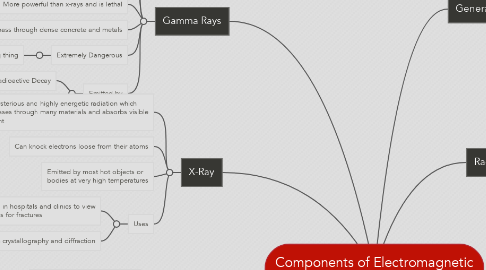
1. Gamma Rays
1.1. Produced by nuclear fusion and unstable nuclei
1.2. Highest Energy EM Waves with very short wavelengths, 10^-11 m to 10^-13 m
1.3. More powerful than x-rays and is lethal
1.4. Can pass through dense concrete and metals
1.5. Extremely Dangerous
1.5.1. Can kill any living thing
1.6. Emitted by
1.6.1. Radioactive Decay
1.6.2. Nuclear Fission
2. X-Ray
2.1. Mysterious and highly energetic radiation which passes through many materials and absorbs visible light
2.2. Can knock electrons loose from their atoms
2.3. Emitted by most hot objects or bodies at very high temperatures
2.4. Uses
2.4.1. Used in hospitals and clinics to view bones for fractures
2.4.1.1. Non-invasive as most of the body, with its tissues, are invisible to X-Rays
2.4.2. For electron crystallography and diffraction
3. Ultraviolet
3.1. wavelength range= 4000 to 10 A
3.2. Produces Vitamin D
3.3. Harmful Effects
3.3.1. Causes skin to turn brown or burn
3.3.2. Damages eye
3.3.3. Destroys plants
3.3.4. Stopped by Earth's atmosphere
3.4. Uses
3.4.1. Sterillises water in ponds and aquariums
3.4.2. Sterillises equipment in hospitals
4. Visible Light
4.1. Occupies a very small part of the entire EM spectrum
4.2. Only a range of energies can be detected by the human eye
4.2.1. From 4000 A (high energy violet) to 7000 A (Low energy red)
4.2.2. Allows us to see the range of colours that we do
5. Infra-red Waves
5.1. Just below visible spectrum, long wavelengths, 1.00 mm to 8 x 10^-7 m or 80, 000 A
5.2. Molecules vibrate and resonate when exposed to infra-red radiation
5.3. Emitted by
5.3.1. Sun
5.3.2. Light Bulbs
5.3.3. IR Devices(Remotes or TVs)
5.4. Uses
5.4.1. IR Camera
5.4.1.1. To view paintings
5.4.2. IR Space Telescope
5.4.2.1. To look into the unseeable parts of our galaxy
5.4.3. IR Goggles
5.4.4. IR Lights
5.4.4.1. To detect charcoal paint
6. Microwaves
6.1. Misnomer, Range=1.0 mm to 3.0 cm
6.2. Polar molecules vibrate and rotate when exposed to microwaves
6.3. Uses
6.3.1. In microwaves to heat food and drinks
6.3.2. In television satellites and dishes to operate in microwave region
6.3.3. In short wave radio operators
6.3.4. In mobile phones
7. Radiowaves
7.1. Longest Wavelength & Smallest Energy
7.2. Cannot be detected unless by proper instruments
7.3. Uses
7.3.1. Entertainment
7.3.1.1. TVs, Radios and Remote Controls
7.3.2. Visualizing the Invisible
7.3.2.1. In unmanned submarines to detect depth and obstruction
7.3.2.2. In robots to go into volcanoes, etc.
7.3.2.3. For space telescopes to see what lies beyond our solar system in space
8. General Properties
8.1. Created by oscillating electrical and magnetic fields. (oscillating perpendicularly)
8.1.1. Direction of wave propagation is perpendicular to both fields.

